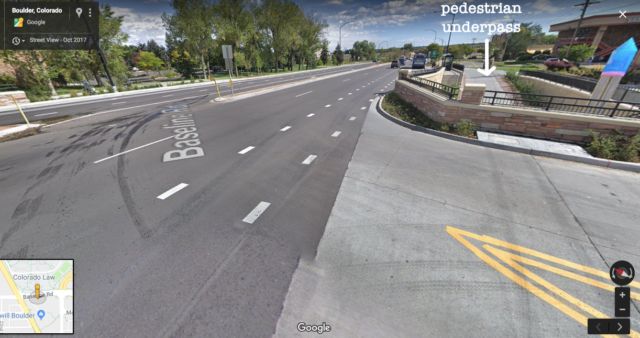Mission: To promote driving less so all may live more.
The previous post was about Laura’s experience of getting hit by a car while in a flashing-light crosswalk (2007). The crosswalk where the accident occurred was replaced by a high-intensity activated crosswalk (HAWK, which provides a flashing yellow light followed by a solid yellow light followed by a red light). After installing the HAWK, Boulder went a step further, replacing it with a pedestrian underpass (the best and costliest solution).

Boulder, CO is a bike capital and has plenty of pedestrians (as do most college towns). Anything Boulder has learned in the past concerning pedestrian and bicyclist safety is probably a lesson some city is about to learn in the present, if it learns at all.
Accordingly, this post and the next will reiterate some points from a few articles on crosswalk safety published in Boulder’s The Daily Camera. The article referred to below was inspired in part by the level of danger the city recognized concerning a few flashing-light crosswalks (Laura’s being at the top of the list).
“Boulder study sheds light on bicycle, pedestrian accidents” (02/04/2012)
Pedestrians
Boulder city officials released the “Safe Streets Boulder Report,” based upon “information gleaned from accidents within city limits between January 2008 and April 2011.”
The report exonerates flashing-light crosswalks (which had become recognized as a likely place to get hit by a car), stating that regular crosswalks were more dangerous, except for the exceptions (Laura’s crosswalk being one of the exceptions). The Daily Camera article summarizes the report’s findings:
Crosswalks of all types accounted for 44 percent of accidents involving pedestrians and 56 percent of accidents involving bikes. But of those, only 6 percent took place in a flashing crosswalk.
The statistics are not that useful, since we don’t know the ratio of non-flashing to flashing crosswalks. Moreover, the Camera article goes on to cite another (2010) study that “found that more than one-third of the crosswalks with flashing lights have led to higher rates of accidents.” Apparently, while some flashing-light crosswalks protect pedestrians, some endanger them.
To its credit, Boulder has removed the flashing-light crosswalks that gave the rest of the flashing-light crosswalks a bad reputation.
In addition, Boulder has now passed rules that (1) require pedestrians to activate the flashing light (makes sense), (2) prohibit bicycles from crossing these crosswalks at a rate exceeding 8 mph (that makes sense, too), and (3) disallow a moving car to pass a car that has stopped for a flashing-light crosswalk whether or not anyone appears in the crosswalk (yay!).
What the Camera article fails to suggest is that crosswalks are inherently dangerous in as much as they provide false security to the pedestrians.
People like myself who cross streets frequently on foot are faced with a dilemma. On one hand are the common crosswalks at an intersection where there are four directions of traffic filled with cars that are trying to change direction. On the other hand, between such intersections is the middle of a block where there are two directions of traffic, with no cars trying to change direction. Often I prefer the second choice, which can be performed stealthily through jaywalking or occasionally where a city such as Boulder has installed either flashing-light crosswalks or, better, HAWKs.
Bicyclists
In general, the Camera article portrays Boulder’s streets as safe, given the number of pedestrians and bicyclists. This assessment is consistent with the “Safe Streets” report and with city and CU campus spokespeople. However, the Camera also provides an interesting contrast in civilian opinions.
First, it quotes Jason Estes, a bike courier, who states, “I think there’s always improvements to be made. But Boulder, I feel, is a great place to ride.”
Then, it quotes Lenore Sparks, who was injured while cycling in Boulder: “Boulder is by far the most dangerous city for cyclists, even more so than Guadalajara and Mexico City, within which I have comprehensive experience cycling.”
Obviously, individual experiences speak louder than statistics, with the result that if you were hit—or your daughter were hit—the streets in Boulder are still not safe enough.
Estes, the courier, also pointed out the common danger to bicyclists crossing at intersections where drivers are turning right on red. The drivers are looking to their left, to spot a window in the traffic. Little do they think about, or see, bicyclists who have the right-of-way but are coming from the driver’s right.
The practical conclusion here is that the prudent pedestrian or cyclist gains more safety by assuming invisibility than by simply being law abiding.
Next post continues using some lessons from Boulder as a springboard for further discussion.
